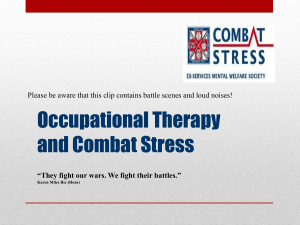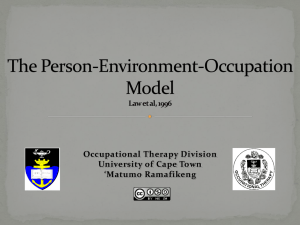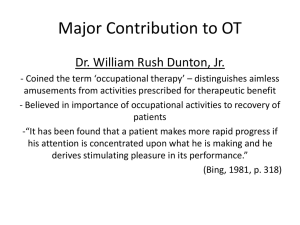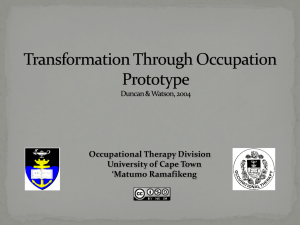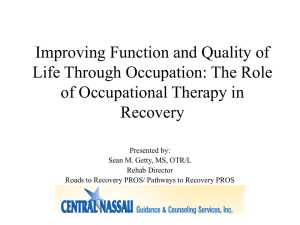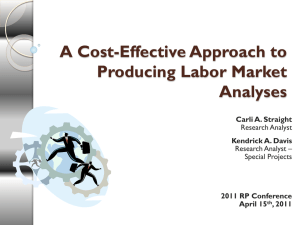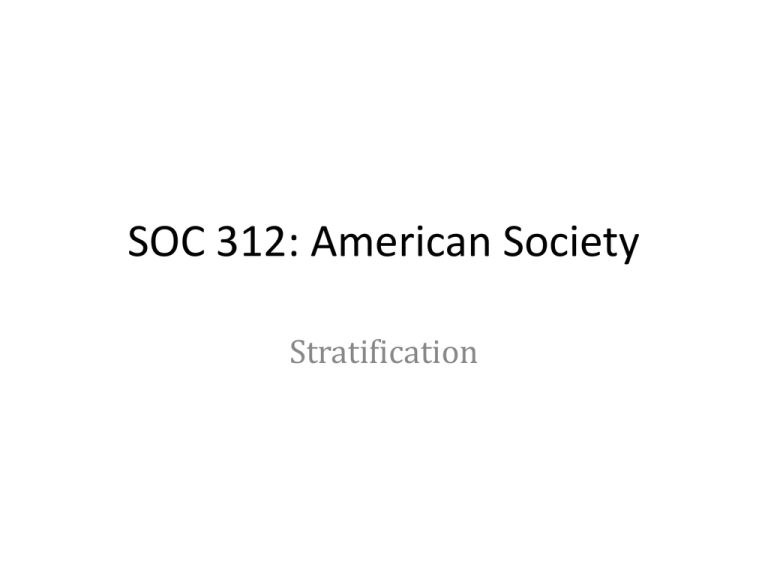
SOC 312: American Society
Stratification
Stratification
• Major area in sociology in the U.S.
• How do we explain the nature and types of
social inequality
– interpersonal: deference or discrimination
– group: in-group/out-group behavior
– organizational: distribution of persons/rewards
over positions
– institutional: enduring race, class, and gender
inequality
History
• Earliest theory: Kingsley Davis and Wilbert
E. Moore, "Some Principles of Stratification,"
ASR 10 (April 1945), pp. 242-249
• But problem of inequality dates back to
Emile Durkheim, Division of Labor in Society
(1893)
– modern (late 19th C) industrial society:
achieved inequality
– replacing traditional society of inherited
(ascribed) status
Durkheim (cont.)
• Inequality was inevitable but nature was
variable
– achieved corresponded to talents and
inclinations: functional in modern industrial
society
– functional not because of efficiency (Herbert
Spencer and Adam Smith)
– served moral function: organic solidarity
Modern Division of Labor
• could maintain society
• reinforce individual commitment to
collective enterprise
• reaffirm sense of belonging to larger
community of society
• regulate behavior: occupational/industrial
groups establish and enforce
standards/ethics
Durkheim Div of Labor (cont.)
• Thus occupational groups and modern
division of labor might replace functions of
family and religion in traditional society
• Durkheim later realized that both religion
and family (and mechanical solidarity)
continued to serve important/critical
function
• But saw predominance of differentiation
and organic solidarity
Durkheim’s Functional Model of the Division of Labor and
Mechanical or Organic Solidarity
-
Division
Of Labor
+
Solidarity
Increasing
Social Density
Durkheim (cont.)
• Potential conflict between achieved and
ascribed status
– ascribed: inherited; sustained simple,
undifferentiated society
– achieved: sustained modern differentiated
society
• Impossible to eliminate inheritance
– But need to minimize its effect—even
affirmative action, for moral/economic viability
Davis and Moore (1945)
• Rooted in functional theory/Durkheim
• assumed
– some occupations more important
– some occupations more difficult to fill
• talent required
• unpleasant nature of work
• years of preparation required
These occupations need to confer higher
status (honor and money) to attract best
and brightest
Davis and Moore’s Functional Model of Stratification
-
Hierarchy
of Rewards
Recruitment
Of Best and
Brightest
+
External
Threat
Cold War (1956-1989)
Competition between U.S. and U.S.S.R.
– military
– industrial
– technological
– ideological
U.S.S.R. launched Sputnik
- inspired space race
- tons of money for eduction
- "rocket science"
Status Attainment and
Occupational Prestige
• Weber: status was honor bestowed by
community of likeminded persons
– celebrated particular lifestyle (e.g. Green or Hip
Hop)
– honored the exemplary taste, virtue, dignity or
style of those who followed this lifestyle
(gourmet, Catholic, recovering alcoholic)
– gave awards, prizes or simply "esteem"
Weber on Class and Status
• Weber viewed status (lifestyle) and class
(life chances) as distinct but related social
interests
– metro-sexuals honor a particular status
– which requires a minimal standard of living
(class-based requirement)
– but not all middle class people are or can be
metro-sexuals
Weber on Party (power)
• Weber viewed party as a third independent
or at least distinct social base for interest
group formation
– parties are actively in pursuit of power (ability
to achieve goals despite resistance)
– sometimes based on class interests
– sometimes based on status interests
– sometimes mixture of both
– sometimes neither: purely political
Status Attainment
• status attainment literature in the U.S. in
1950s and 1960s
– not well rooted in classical theory (or any
theory)
– used "status" to refer to prestige that was
accorded a particular position or occupation
– developed empirically rather than theoretically
• inductive statistics
• rather than deductive theory
Occupational Mobility Tables
• Beginning with the Warner, Yankee City
Studies
• sociologists in U.S. have viewed statification
by ill-defined social classes
– middle class versus working class (Lynds in
Middletown)
– upper, middle, lower (and intermediate
categories) used by Warner et al
Featherman and Hauser
• Used manual/nonmanual occupations as
major categories
• created categories of upper and lower
manual and nonmanual, as opposed to farm
• used these categories to study occupational
mobility, father to son
Outflow Mobility, Father to Son Occupation, 1962 and 1973
(Kerbo, Sixth Edition (2006), p. 373)
Son's Current Occupation
Father's
Occup
Up NonM
Up NM
56.8%
16.7%
11.5%
Low NM
43.1%
23.7%
Up Man
24.7%
Low Man
Lo NonM
UpManual LoManual
Farm
Total
13.8%
1.2%
100%
14.6%
17.0%
1.7%
100%
17.0%
28.6%
28.8%
1.2%
100%
17.9%
14.8%
21.9%
43.4%
1.9%
100%
Farm
10.3%
12.3%
19.3%
35.9%
22.2%
100%
Total
24.5%
15.9%
20.2%
31.7%
7.7%
100%
1962 (N=10,550)
1973 (N=20,850)
Up NM
59.4%
11.4%
12.8%
15.5%
.9%
100%
Low NM
45.1%
16.6%
16.4%
20.7%
1.2%
100%
Up Man
30.9%
12.2%
27.7%
28.1%
1.2%
100%
Low Man
22.9%
12.1%
23.9%
40.1%
1.0%
100%
Farm
16.4%
9.0%
22.9%
37.1%
14.5%
100%
Total
31.2%
11.8%
21.9%
31.0%
4.1%
100%
Featherman and Hauser (cont.)
• the diagonal indicates the inheritance of
occupation: 57% of sons of upper nonmanual fathers find themselves in upper
non-manual
• these tend to be the largest numbers (only
10% of farmers' sons in upper non-manual)
• above the diagonal is downward mobility
• below the diagonal is upward mobility
• lots of upward mobility, increasing 19621973
Blau and Duncan's Occupational
Prestige Scores
• Peter Blau and Otis Dudley Duncan (1967)
– developed ratio (or, at least, interval) scale for
occupational prestige
– asked people to rate 45 occupations: excellent,
good, fair, poor; calculated % rated excellent or
good (Y)
– matched occupations with 1950 census and
computed percent of people in that occupation
with high school or more education (X1) and
percent in that occupation earning $3500 plus
(X2)
Predicting Occupational Prestige
High
.
.
.
.
Prestige
of
Occupation
Y
.
...
...
..
......
.
.
.................
.
..............
.. .
.................
.
..
............
.
........... ........
..
..............
.
..........
..
... . .
....
.Yo observed values
Predicted
Prestige
Score: Yp
.....
...
...
.
low
Average income and education of occupation (X1+X2)
High
Blau and Duncan
• using ordinary least squares regression
– predict prestige for occupations that were not
among the 45
– using the percent in each occupation with high
school plus (x1) and percent earning $3500
plus (x2)
– Yp=a+B1X1+B2X2+e
– the line is drawn to minimize the error:
– ∑(Yo-Yp)2/N (N is the number of
observations)
Blau and Duncan (cont.)
• the OLS model fit the data extra-ordinarily
well (for social science)
– Multiple R=.91
– that means that 83% of the variance in
occupational prestige was explained by
education and income (as measured in this
model)
– this was an amazing feat, which made Blau and
Duncan famous
Blau and Duncan (cont.)
• they used this model to predict prestige
scores for every occupation in the U.S.
census
– coding education and income
– predicting occupational prestige
– they then used this wonderful ratio scale
variable to predict mobility from father to son
– this became the standard model of status
attainment (and is still popular)
Blau and Duncan's Path Model (Kerbo, p. 394)
X
X
.859
Father's
Education
.310
Son's
Education
.753
.394
Son's
Occupation
.440
.279
.115
.516
.281
Father's
Occupation
.224
Son's
First Job
.818
X
The Wisconsin School
• social psychologists at U. Wisconsin
– attempted to specify the effects of individual
and group differences
– included IQ and academic performance
– included evaluation by significant others
(teachers, etc.)
– including attitudes (educational and
occupational aspirations)
Figure 12-7. Wisconsin School Path Model (Kerbo, p. 396)
X
X
.859
Parental
SES
.246
.179
.288
Mental
Ability
.589
Significant
Others
Occupational
Aspirations
.441
.227
.320
Educational
Attainment
.261
Academic
performance
.508
.218
.152
.522
.792
X
.627
Occupational
Status
.457
Educational
Aspirations
.218
.808
X
.778
.768
X
.654
X
Operationalization
• occupational status (Blau & Duncan)
(parents average occ and ed)
• IQ measured by standard WI test
• aspiration (occ/ed hope in 1957: 7 years
earlier)
• peer influence: perceived parental and
teacher encouragement for college and
friends college plans
• academic performance is ranking in hs class
Critiques of Status Attainment
• Hauser and his students: occupational
mobility largely determined by changes in
occupational structure
– 1950s and 1960s: creation of well-paid jobs in
manufacturing increased mobility to upper
white collar (nonmanual) and blue collar
(manual)
– 1970s and 1980s: relative decline of
manufactures and rise of sales and service
decreased mobility: more lower white and blue
collar jobs
Outflow Mobility, Father to Son Occupation, 1962 and 1973
(Kerbo, p. 373)
Son's Current Occupation
Father's
Occup
Up NonM
Up NM
56.8%
16.7%
11.5%
Low NM
43.1%
23.7%
Up Man
24.7%
Low Man
Lo NonM
UpManual LoManual
Farm
Total
13.8%
1.2%
100%
14.6%
17.0%
1.7%
100%
17.0%
28.6%
28.8%
1.2%
100%
17.9%
14.8%
21.9%
43.4%
1.9%
100%
Farm
10.3%
12.3%
19.3%
35.9%
22.2%
100%
Total
24.5%
15.9%
20.2%
31.7%
7.7%
100%
1962 (N=10,550)
1973 (N=20,850)
Up NM
59.4%
11.4%
12.8%
15.5%
.9%
100%
Low NM
45.1%
16.6%
16.4%
20.7%
1.2%
100%
Up Man
30.9%
12.2%
27.7%
28.1%
1.2%
100%
Low Man
22.9%
12.1%
23.9%
40.1%
1.0%
100%
Farm
16.4%
9.0%
22.9%
37.1%
14.5%
100%
Total
31.2%
11.8%
21.9%
31.0%
4.1%
100%
Ross Stoltzenberg and Students
• Argued that both industry and occupation
constrain workers and their ability to
increase their earnings
– Return on education
• Managers and professionals
• Research and development
• Versus line workers in manufacturing
– Return on experience
• White collar/managerial-professional versus manual
Career Earnings
white
collar
white
collar
earnings
earnings
blue
collar
Years of education
blue
collar
Years of experience
Randy Hodson and students
• Labor markets are segmented: dual
economy
– Core sector: large firms, large market shares,
large and stable/predictable profits, offer high
pay and benefits, high returns on education and
experience
– Peripheral sector: small firms, small market
shares, small and unstable profits, low pay and
no benefits or job security, low returns on
education and experience
Erik Olin Wright and students
• Status attainment and labor market theories
ignore exploitation
– Value of worker’s labor is appropriated
• Directly, as profit (or reinvested in capital) by
employer
• Indirectly, as surplus wages/bonuses, by managers
and supervisors
– Employers and managers earn more and receive
greater return for education
Wright and Perrone (1977)
employers
high
managers
earnings
workers
low
Years of education
high
Erik Olin Wright and students
• Need to look at Marxist class categories
• Need to look at movement of capital and labor
• In and out of industries
• In pursuit of windfall/stable profits
• In pursuit of high wages/stable employment
• As Hogan (1990) argued, industrial
frontiers offer high risk/high profits
– Entrepreneurial labor and capital absorbs risks
– Establishes reliable rates of return (or not)
Hogan (1990) continued
• Reliable rates of return (not large but
reliable profits) attract big capital
– Economies of scale yield higher rates of return
(bigger potential profits)
– Only if rate of return is reliable
– Otherwise excessive overhead and sunk costs
make it hard to respond to market fluctuations
– Which is why entrepreneurs tend to be small
scale and are able to exploit industrial frontiers
Marxist Perspective
• Big (corporate/monopoly) capital and big
(unionized) labor yield reliable profits and
wages in what Hodson calls the “core”
sector
• But proletarianization reduces skill and
return on skill as big capital replaces skilled
labor with machines and unskilled machine
minders
Marxist Perspective (continued)
• The extent to which there are opportunities
for higher wages or better jobs depends on
the rate of
– emerging industrial frontiers (rocket science in
the 1950s, computers in the 1970s, micro
computers in the 1980s, the internet.com world
of the 21st century)
– and proletarianization within industrial sectors
Wright and his students
• Wright and Perrone (1977) also looked at
race and gender differences
– In earnings
– Within class
– Return to education within class
• Findings
– Black and white male managers: intercept but
not slope differences
– White women managers: intercept and slope
differences
Wright and Perrone (1977)
white male mangers
high
black male managers
earnings
white female managers
low
Years of education
high
Featherman and Hauser : Black
Mobility, 1962 and 1973
• Virtually no inheritance of occupation for
blacks in 1962
– Contrast to whites (see above)
– Virtually all black men in lower manual occs
• Some improvement in 1973
Table 12-5. Black Outflow Mobility, Father to Son
Occupation, 1962 and 1973 (Kerbo , p. 381)
Son's Current Occupation
Father's
Occup
Up NonM
Up NM
13.3%
10.0%
13.7%
Low NM
8.3%
14.0%
Up Man
8.2%
Low Man
Lo NonM
UpManual LoManual
Farm
Total
63.0%
0.0%
100%
14.0%
63.7%
0.0%
100%
10.9%
10.9%
67.0%
3.0%
100%
6.7%
9.1%
11.1%
71.0%
2.1%
100%
Farm
1.2%
5.4%
7.1%
66.3
19.9%
100%
Total
4.5%
7.7%
9.4%
67.9%
10.5%
100%
1962
1973
Up NM
43.9%
11.8%
8.3%
36.0%
0.0%
100%
Low NM
19.5%
20.8%
13.4%
45.5%
.8%
100%
Up Man
16.3
13.9%
15.8%
53.7%
0.2%
100%
Low Man
12.1
12.2%
13.7%
61.0%
1.0%
100%
Farm
5.1
6.8%
16.5%
63.2%
8.4%
100%
Total
11.6
10.8%
14.7%
59.4%
3.5%
100%
Race and Gender Gaps
• Many studies, 1977-2009
– racial differences (black/white male earnings)
interpreted/specified by education and
occupation/class
– gender differences remain after controlling for
education and occupation/class
– women exceeding men on education and
gaining access to managerial/professional jobs
– gender gap in earnings is shrinking
Progress in Reducing Race and
Gender Earnings Gaps, 1974-2004
• Gender/racial gap and measurement biases
– include all workers, or fulltime, year-round
– Mean versus median earnings
• Generally, gender gap declines and racial
gap remains the same
• white women earning more than black men?
(depends on measurement)
Mean and Median Annual Income in 2004 for Fulltime, Yearround Workers: White and Black Men and Women (with gaps:
percent of white male earnings)
White
Men
White
Women
Black
Men
Black
Women
Median
$46,986
$34,878
(74%)
$31,732
(68%)
$29,145
(62%)
Mean
$62,755
$42,504
(68%)
$40,078
(64%)
$33,831
(54%)
N
41,977
29,121
5,681
5,960
Source: Richard Hogan and Carolyn C. Perrucci, “Gender, Race, and Income Gaps,” in
Robert Perrucci and Carolyn Perrucci (eds.), Transformation of Work in the New
Economy (Los Angeles: Roxbury Publishing Company, 2007)
Mean Income (in 2003 dollars) for All White and Black Male and
Female Workers (With Income Gap: percent of White Males)
White
Males
White
Females
Black
Males
Black
Females
2004
(gap)
$46,868
$25,979
(55%)
$29,880
(64%)
$22,581
(48%)
1994
(gap)
$40,334
$20,981
(52%)
$24,817
(62%)
$18,353
(46%)
1984
(gap)
$34,925
$16,519
(47%)
$20,419
(58%)
$14,527
(42%)
1974
(gap)
$33,842
$13,813
(41%)
$20,616
(61%)
$12,266
(36%)
Year
Source: Hogan and Perrucci 2006 (census.gov, 2005)
Racial and Gender Gaps (Compared to White Men) in Mean
Income, 1974-2004
0.7
0.6
0.5
0.4
Black F
Black M
White F
0.3
0.2
0.1
0
1974
1984
1994
2004
Source: Hogan and Perrucci 2006 (census.gov, 2005)
Race and Gender Gaps (conclude)
• women's irregular labor force participation
– caregivers for family
– miss on-the-job training and mentoring
• glass ceiling or discrimination
– women steered to clerical, service, domestic
– denied jobs in mfg, construction, transportation,
and skilled trades and crafts
– women occupy lower tier in all industries: el.
ed, admin. prof., Liberal Arts,
Erik Olin Wright (1997)
• women have access to managerial and
professional positions
• but don't earn as much as comparable men
• compared to black men, more selfemployed, expert workers, and unskilled
workers; less skilled workers and expert
managers
• most women are unskilled workers
Wright (Class Counts 1997, p. 68) Class by Race and Sex
Class
White Males
White Females
Black Males
Black Females
Capitalist
3.0%
0.7%
0%
0%
Small employer
8.2%
4.9%
0%
1.3%
Petit Bourgeois
6.4%
8.8%
3.6%
0%
[Tot Self Empl
17.6%
14.4%
3.6%
1.3%]
Expert Mgrs
8.5%
2.8%
5.1%
0%
Skilled Mgrs
5.7%
2.4%
2.0%
0%
Unskilled Mgrs
2.3%
3.9%
1.0%
6.3%
Expert Super
4.2%
1.7%
1.3%
1.7%
Skilled Super
7.9%
4.3%
7.5%
2.0%
Unskilled Supr
5.0%
9.3%
4.6%
7.7%
Experts
3.2%
3.5%
2.9%
1.8%
Skilled Worker
17.4%
7.7%
23.3%
10.9%
Unskilled Wkr
28.2%
50.0%
47.7%
68.4%
Hogan and Perrucci
• looking at older persons and retirees
– substantial gender and racial differences in
employment earnings from longest held job
• effect of self-employment (for whites)
• especially for professionals (for whites)
• effect of marriage
– employment (white men)
– retirement (white women)
– gender gap greater in employment earnings
– racial gap greater in retirement earnings
Tilly, Durable Inequality (1998)
• Categorical Inequality: unequal relations between
mutually exclusive categories of individuals: "black/white,
male/female, married/unmarried, and citizen/noncitizen"
(p. 8).
• relationships rather than positions or distribution of
resources
• Exploitation: derriving profit or benefit from relations
through which "powerful, connected people command
resources from which they draw significantly increased
returns by coordinating the efforts of outsiders whom they
exclude from the full value added by that effort" (p. 10).
Tilly (cont)
• Opportunity Hoarding: limiting access to the potentially
profitable: means through which "members of a categorically
bounded network acquire access to a resource that is valuable,
renewable, subject to monopoly, supportive of network
activities, and enhanced by the network's modus operandi"
(p.10).
• Tilly argues that familiar and enduring relations of social
inequality, including “class, gender, race, ethnicity” (p. 4),
although qualitatively different, are established through
"exploitation" and "opportunity hoarding" and then
generalized through "emulation" and institutionalized through
"adaptation."
Applying Tilly to the Analysis of Class, Race, and Gender
Inequality (Hogan 2001)
Class, Race, Gender, and Patronage Relations Distinguished by Mechanism
of Surplus Appropriation and Locus of Relations
Locus
of
Relations
Mechanism of Surplus Appropriation
Exploitation
Opportunity
Hoarding
Production
Class
Patronage
Reproduction
Gender
Race
How Do We Explain Inequality?
• Functional
– necessary but variable
• ascribed/inherited
• achieved
• status attainment
• Weberian/Labor market
– inevitable but multi-faceted: class, status, party
– unequal distribution of resources
– competition and hoarding
How Do We Explain Inequality? (cont.)
• Marxist
– imposed and unnecessary/unnatural
• exploitation of labor
• accumulation of capital
– investment/accumulation
• frontiers
• proletarianization
• Tilly offers synthesis or combination of Weberian and Marxist
• Oliver and Shapiro offer a Weberian model of inequality
– but argue that white hoard wealth
– focus on racial gap in wealth rather than income
Oliver and Shapiro
• There is little racial difference in income,
once we control for occupation, education,
and marital status
– racial earnings gap for dual-income couples is
only 85%
– typo in table 5.2 (p. 99)
• black white collar income should be $24,320
• so ratio is 70%
• but racial gap is wealth is huge
Oliver and Shapiro (cont.)
• racial gap in wealth is huge even for
– upper middle class professionals
– married
– dual income
– children of middle class blacks
• blacks lack assets, especially financial assets
(capital)
Oliver and Shapiro (cont.)
• racial gap cannot be explained by status
attainment models
– high status blacks lack assets
– no evidence this is due to differences (p. 138)
• in savings
• In consumption
• much of difference is due to housing values
– FHA. real estate, banking practices
– white flight and discrimination
Oliver and Shapiro (cont.)
• indirect evidence of inherited inequality
(pp. 154-159)
• Hogan and Perrucci (1998) cite Smith
(1993), "for every dollar of inherited wealth,
total net worth increases by 36¢
• estimate that black inheritance is only 18%
of white inheritance (on average)
Oliver and Shapiro (cont.)
• Also argue against Weberian labor market,
life-chances, competition model
– use occupational mobility tables (p. 160)
• whites more likely to experience upward mobility in
upper nonmanual class (.364 from LBC exceeds
occupational inheritance of UWC blacks)
• blacks more likely to experience downward mobility
(.234 LBC black children of UWC parents)
– claim discrimination at work; lack of access to
quality education and social networks (p. 162)
Oliver and Shapiro (cont.)
• challenge Marxist or class approach
– use Weberian/Hauser mobility model
– wealth/income for mobile (p. 166)
– income is "earned" while wealth is
"transmitted" (p. 166-7)
– but this finding does not hold up for blacks (p.
169)
Median Income and Net Worth for White Families and Other Families in
2001(From Dollars & Sense, The Wealth Inequality Reader, 2004, p. 14)

